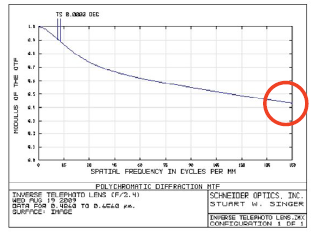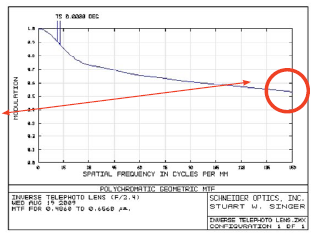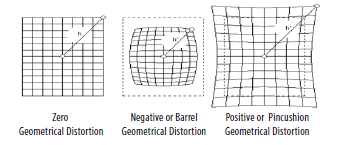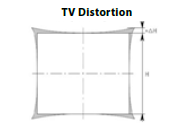TV distortion values are typically much lower than geometric distortion values (See Figure 1 on the previous page). We choose to present a geometric distortion value on our data sheets because it provides a much truer indication of lens performance than TV distortion, but that lower distortion number on the competitor’s data sheet sure looked attractive.
It almost worked, and there’s the rub!
The technical data sheet — the most basic form of communication about lens specifications in our industry — should provide an objective and uniform key to helping buyers compare lenses. But it doesn’t. Data sheets can be very misleading. The comparisons are not apples to apples because the format and the data presented in data sheets are not held to an international standard and are not overseen by a governing body. Additionally, even when certain lens parameters within a data sheet are tied to an ISO standard, the standards themselves are poorly understood by the engineering community.
Have you ever looked at data sheets from Japanese, German, and U.S. lens manufacturers side by side? They have almost nothing in common. But the problem isn’t rooted in cross-cultural issues. Compare data sheets from three lens makers in the same country, and the result is the same. Each company uses its own format and nomenclature. Each company essentially is reinventing the wheel, but it is the buyer of the lens who, as we’ll see, faces the prospect of a flat tire.
In order to help optical engineers and system designers view lens data sheets more critically, better circumvent traps hidden within, and ask the right questions of lens providers, we suggest focusing on the following key datasheet parameters:
1. Modulation transfer function (MTF)
2. Focal length
3. f-stop
MTF: A Convenient Way to Mislead
The single most important thing for a buyer to consider when trying to decide if a specific lens will meet their system needs is to look at lens performance. The data-sheet entry that best approximates performance is modulation transfer function, better known as MTF.
What most optical engineers and designers don’t realize is that there are many different types of MTF, each with varying values that can artificially inflate an estimate of lens quality. Because there are no standards on how lens makers report MTF on a data sheet, it is left to the buyer to ascertain which kind of MTF he or she is assessing. This quandary is made even more difficult by the fact that many vendors use the term MTF generically on their data sheets.
Don’t fall for it. All MTFs are not created equal.
The generic use of MTF is a convenient way of misleading the reader. Used generically, MTF is commonly shorthand for “geometrical MTF,” a value that does not take into account diffraction, and thus provides a higher, seemingly more attractive number. The most rigorous and useful type of MTF — one that is the best indicator of the lens’ true performance potential in a vision system across wavelengths — is called “polychromatic diffraction MTF.”
Calculating polychromatic diffraction MTF is a better way to evaluate lens performance than geometric MTF because it better reflects how a lens will be used in the real world. Namely, it takes into account the physics of optics, which includes diffraction, something not accounted for in geometric MTF. Again, you can see from the calculations that polychromatic diffraction MTF is a higher number, and, to the untrained eye, that means “less good.” Not so. (See Figure 2 on the next page).
Geometric MTF, a much easier calculation than polychromatic diffraction MTF, represents how MTF was calculated 30 to 40 years ago, i.e., before computers. For engineers building high-end optical systems to operate in pre-PC environments, geometric MTF is just the ticket!
We’re being cheeky here, of course, but there is nothing funny about not labeling what kind of MTF a lens manufacturer is including on its data sheet. To pass off geometric MTF as true MTF and hope the buyer doesn’t look closely is not illegal, but it’s not right. Unfortunately, this is an area where the lack of transparent, highly understood data-sheet standards has hurt the experienced engineer and neophyte alike.
To be clear, manufacturers who do this aren’t breaking the law. The MTF number they are providing is accurate, but by leaving out an MTF descriptor (“geometric” in this case), the manufacturer creates a circumstance where the buyer is likely to stumble upon a significant gap in performance that will slow down, add to the cost of, or imperil the development of their vision system.
At Schneider Optics, we often answer questions from prospective buyers about why our MTF values don’t compare favorably with various competitors. Nine out of 10 times, they are shocked to learn not only that there are multiple kinds of MTF, but also that they haven’t been comparing apples to apples. Now they know. And so do you. Focal Length: When 100 ≠ 100 Even when there is an International Organization for Standardization (ISO) or Deutsche Industrial Normen (DIN) standard associated with a lens specification, many buyers are unaware of the standard and, of even greater consequence, the potential ramifications of that standard on their vision-design system. Lens focal length (f') provides a telling example.
Fig. 2: Diffraction MTF vs. Geometrical MTF for the same lens

Diffraction MTF Polychromatic

Geometrical MTF Polychromatic
The focal length of a lens is pretty straightforward, right? Whether you need a 100mm lens for a camera, or 20 100 mm lenses for a vision system monitoring a manufacturing process, the data sheet states unequivocally that the buyer is getting a 100mm lens. But did you know that according to DIN standard 4522, section 11, the standard for engraving a lens for focal length is ±6 percent? The majority of lens buyers don’t — this isn’t taught in engineering school!
For that company buying 20 100 mm lenses for its web-inspection system, say for measuring defects over a large swath of material, the impact of the DIN standard for focal length is significant. It could mean that instead of buying 20 uniform 100 mm lenses, they are actually getting lenses of varying focal lengths, running from 94 mm to 106 mm (where the delta between what they buy and what they get = aggravation, extra work or rework, and, at its worst, a system failure, exposing the engineer’s ignorance of the lens-buying process). In practical terms, this would mean every single lens and camera would need to be set up at a slightly different distance to give all the same magnification and field of view. Think, too, of the poor stereo-vision designer!
One way to fight back against this imprecision is to ensure you know exactly what you are buying. And to do so, you have to ask questions. A reputable manufacturer of quality lenses will be able to answer your questions about focal length and tolerance from lens to lens, lot to lot, and year to year.
An empowered buyer needs to know more than the data-sheet spec: he or she must drill down on the presented values and only work with manufacturers who really know their wares, produce lenses at tight tolerances, publish them with accuracy, and work collaboratively with you to ensure you are buying the best lens for your system.
f-number: Seeing the Light
Similar to focal length, the f-number (f/# or f-stop) — what controls the amount of light going through the lens — is addressed by an international standard, but, similarly, most buyers don’t know the standard. And, again, what they don’t know can hurt them.
We think you will be surprised by what the ISO standard (ISO 517) dictates in terms of f-stop tolerances. When the f-stop is 5.6 or slower — for example, settings of f/5.6, f/8, f/11, f/16, or f/22 — the f-numbers need only be accurate to ± one-half a stop, or ± 25 percent of the light. That is a huge difference! Imagine trying to set up 20 lenses in a row in your vision system with each turned to f/8, knowing they can all be off by± 25 percent! And when the lens is faster, set to f/4, f/2.8, or f/2, the tolerance is ± one-third of a stop, or ± 16.6 percent of the light. You could drive a bus through these gaps, which certainly doesn’t help when you are trying to set up multiple lenses in a row for your vision system.
Some might consider a simple workaround to these variances. For example, couldn’t the f-number be adjusted slightly for each lens, so each had the same amount of light in the system? Yes, but remember what the lenses are being set up to do. The lenses would no longer be working at their proper f-number, affecting the depth of field and, consequently, the focus!
This topic of workarounds brings us back to our aerospace engineer mentioned earlier. The lens specification that tripped him up was distortion, another spec without a standard. The real distortion of the lens he almost bought would have crippled the system being designed, something that could have delayed the launch of a satellite and cost people their jobs. The error surely would have been detected downstream before a more catastrophic consequence, but that’s not good enough. Engineers work in a world of exact values and need the means to get them before they buy.
Conclusion
Experience is a great teacher. Through many years of experience, we have learned a lot about the shortcomings of data sheets and the rules, or lack thereof, that govern them. Here’s a quick summary:
1. Technical data sheets for optical lenses are not governed by standards, enabling each vendor to present the data it wants in the way it wants, which can lead to misleading performance claims and hamper apples-to-apples comparison.
2. Generic specification terms, such as MTF, often gloss over exactly what they are measuring and the variety of ways they are calculated, again leaving it to the buyer to do the detective work.
3. Even when specs are regulated by an ISO or DIN standard, the standards are often: a) not well understood by lens buyers; and b) typically wide enough to drive a bus through them. Efforts to bring industry players together to develop common standards have failed and been abandoned. This puts the onus squarely on the buyer to become better informed and more inquisitive. It also leaves it up to reputable manufacturers to move away from subterfuge and present their data clearly — calling out the type of MTF, for example.
And where these two parties — buyer and seller — will continue to intersect is on the phone. Informed buyers need to ask the right questions, digging into the details behind key specs. In response, quality providers need to wow their buyers with a thorough knowledge of their lens tolerances and willingness to share them in a helpful and transparent way.
In the meantime, remember, you get what you pay for. Caveat emptor.







